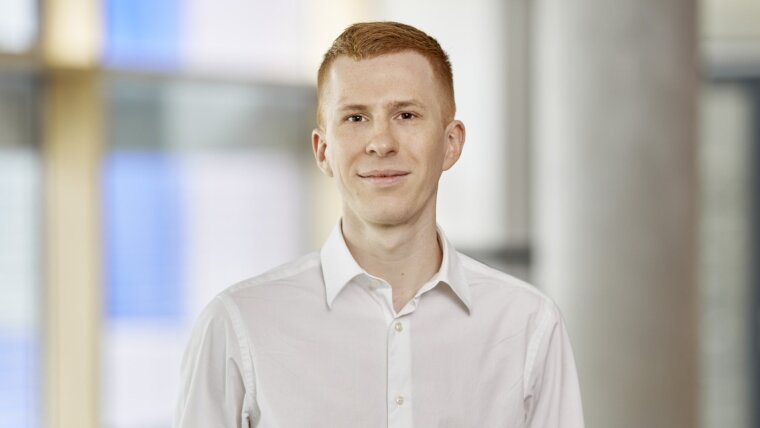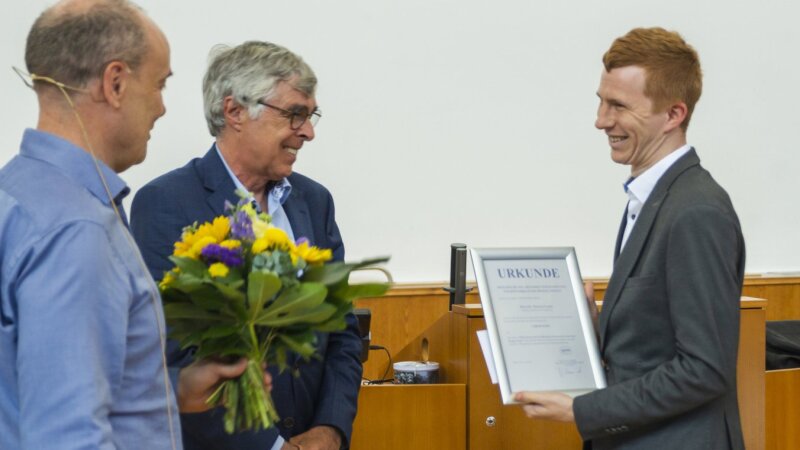
- Light
- Forschung
Published: | By: Ira Winkler
Prof. Peschel, Dr. Schniewind and Dr. Goebel at the award ceremony of the Faculty's Alumni Day.
Image: MK BoseaThorsten Albert Goebel has been awarded the Dr.-Ing. Siegfried Werth Foundation's doctoral award for the best dissertation in the field of optical metrology.
Dr. Goebel completed his doctorate under the supervision of Prof. Dr. Stefan Nolte on the subject of “Femtosecond pulse-written fiber Bragg gratings as multi-channel filters”. In his impressive work, he made decisive progress in the field of fiber Bragg gratings for optical filters and sensors for multicore fibers. The areas of application are wide - narrow-band and low-loss optical filters for sensor technology, spectroscopy and astronomy.
Groundbreaking results
The starting point of his research was the development of a simulation tool for the calculation and optimization of complex lattice structures with which multi-resonant fiber Bragg gratings can be realized. The results showed that the complex lattice structures of the so-called aperiodic fiber Bragg gratings are difficult to implement with the established phase mask technique and that these challenges have not yet been finally solved. Even a highly complex phase mask developed did not produce the desired results within the fiber due to the diffraction effects of small structures. However, together with the research group led by Prof. Alexander Fuerbach from Macquarie University in Sydney, Australia, a solution was developed using a direct inscription method. This laid the basis for successfully realizing an optimized setup for the inscription of complex multi-resonant fibre Bragg gratings with up to 20 resonances. As a next step, he faced the challenge of overcoming the shadowing effects caused by the fiber cores in order to be able to inscribe fiber Bragg gratings in multi-core fibers as well. Dr. Goebel solved this challenge with a high-precision rotating inscription process and a novel multi-core fiber design, which was developed together with the Fraunhofer IOF.
With the combination of the novel inscription method and the adapted fiber design, Mr. Goebel succeeded in creating a filter that overlaps all cores. This was thus the first experimental demonstration of a targeted fiber Bragg grating filter in a 12-core fiber.
Thorsten Goebel thus broke new scientific ground, as by overcoming the previous limitations, new spectral ranges for optical filters and sensors can be opened up in the future, enabling new spectroscopic and sensor applications.
Mr. Goebel's research work has made a decisive contribution to low-loss spectral filtering in various application scenarios. Important milestones have been achieved, particularly in spectroscopy and 3D fiber sensor technology, and future applications under real conditions are conceivable.
Outstanding achievements
During his doctorate, Goebel published 13 papers, applied for two patents (one of which has already been granted) and completed a research stay in Australia. His outstanding scientific work has already been recognized with the “2018 Best Student Presentation Award” from SPIE Photonics West.
Prof. Dr. Andreas Tünnermann praised Goebel's “outstanding knowledge of fiber optics” and his “extremely goal-oriented and consistent” way of working. The presentation of the doctoral award at the Alumni Day of the Faculty of Astronomy and Physics on 7 June 2024 recognizes Goebel's “decisive contribution to low-loss spectral filtering in various application scenarios”.
Visionary motivation and future prospects
Thorsten Goebel's fascination with astronomy was a driving force behind his research work. Inspired by the exploration of distant stars and planets, he focused on the near-infrared spectral range around 1500 nm, where the signatures of strongly red-shifted stars and exoplanets can be found. One of the biggest challenges in this region is the emission of excited OH radicals in the Earth's atmosphere, which makes it difficult to observe the actual signals.
The aim of Goebel's work was to develop filters that very selectively suppress the OH lines and allow the remaining light to pass through. This filter function was to be integrated into the fibers, as the telescope signals are usually coupled into fibers anyway. In order to suppress many lines, Thorsten Goebel chose an aperiodic refractive index pattern and developed the method described above for picometer-precise inscription in the cores of special glass fibers.
The first use of the filters on a telescope is planned for the end of the year, which underlines the practical applications of his work. With his outstanding work, Thorsten Goebel has made special contributions in the field of extremely sophisticated measurement technology and is therefore a worthy and fitting winner of this year's Siegfried Werth Prize.
Congratulations Thorsten on this achievement!
